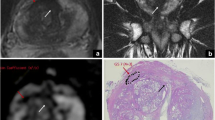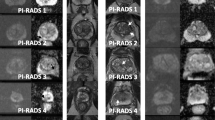Abstract
Purpose
In this article we take a critical look at the key changes of the newest edition of the Prostate Imaging Reporting and Data System (PI-RADS) version 2.1 (v2.1) and indicate future directions for further development of the system.
Conclusion
PI-RADS v2.1 addresses some of the shortcomings of its widely embraced precursor version 2, largely to simplify interpretation and improve interobserver agreement without changing the fundamental acquisition and scoring guidelines. Biparametric MRI is acknowledged in the newest version, but multiparametric MRI including dynamic contrast-enhanced imaging is still recommended for most scenarios. Management recommendations and guidance on evaluation of follow-up MRI’s are still not included in the system.



Similar content being viewed by others
References
Turkbey B, Rosenkrantz AB, Haider MA, et al. (2019) Prostate Imaging Reporting and Data System Version 2.1: 2019 Update of Prostate Imaging Reporting and Data System Version 2. Eur Urol 76(3):340–51
Barentsz JO, Richenberg J, Clements R, et al. (2012) ESUR prostate MR guidelines 2012. Eur Radiol 22(4):746-57
Weinreb JC, Barentsz JO, Choyke PL, et al. (2016) PI-RADS Prostate Imaging- Reporting and Data System: 2015, version 2. Eur Urol 69:16–40
Woo S, Suh CH, Kim SY, et al. (2017) Diagnostic Performance of Prostate Imaging Reporting and Data System Version 2 for Detection of Prostate Cancer: A Systematic Review and Diagnostic Meta-analysis. Eur Urol 72(2):177-188
Rosenkrantz AB, Ginocchio LA, Cornfeld D, et al. (2016) Interobserver Reproducibility of the PI-RADS Version 2 Lexicon: A Multicenter Study of Six Experienced Prostate Radiologists. Radiology 280(3):793-804
Morris EA, Comstock CE, Lee CH, et al. (2013) ACR BI-RADS® Magnetic Resonance Imaging. In: ACR BI-RADS® Atlas, Breast Imaging Reporting and Data System. Reston, VA, American College of Radiology
Spilseth B, Ghai S, Patel NU et al. (2018) A Comparison of Radiologists' and Urologists' Opinions Regarding Prostate MRI Reporting: Results From a Survey of Specialty Societies. AJR Am J Roentgenol. 210(1):101-107
Hansen NL, Barrett T, Lloyd T et al. Optimising the number of cores for magnetic resonance imaging-guided targeted and systematic transperineal prostate biopsy. BJU Int. 2019 Jul 15. https://doi.org/10.1111/bju.14865. [Epub ahead of print] PubMed PMID: 31306539.
Rais-Bahrami S, Türkbey B, Rastinehad AR et al. (2014) Natural history of small index lesions suspicious for prostate cancer on multiparametric MRI: recommendations for interval imaging follow-up. Diagn Interv Radiol 20(4):293-8
Ullrich T, Quentin M, Arsov C et al. (2018) Risk Stratification of Equivocal Lesions on Multiparametric Magnetic Resonance Imaging of the Prostate. J Urol 199(3):691-698
Schoots IG (2018) MRI in early prostate cancer detection: how to manage indeterminate or equivocal PI-RADS 3 lesions? Transl Androl Urol 7(1):70-82
Liddell H, Jyoti R, Haxhimolla HZ (2015) mp-MRI Prostate Characterised PIRADS 3 Lesions are Associated with a Low Risk of Clinically Significant Prostate Cancer - A Retrospective Review of 92 Biopsied PIRADS 3 Lesions. Curr Urol 8(2):96-100
Washino S, Okochi T, Saito K et al. (2017) Combination of prostate imaging reporting and data system (PI-RADS) score and prostate-specific antigen (PSA) density predicts biopsy outcome in prostate biopsy naïve patients. BJU Int 119(2):225-233
Cucchiara V, Cooperberg MR, Dall'Era M, et al (2018) Genomic Markers in Prostate Cancer Decision Making. Eur Urol 73(4):572-582
Vourganti S, Rastinehad A, Yerram N, et al. (2012) Multiparametric magnetic resonance imaging and ultrasound fusion biopsy detect prostate cancer in patients with prior negative transrectal ultrasound biopsies. J Urol 188:2152–2157
Distler FA, Radtke JP, Bonekamp D, et al. (2017) The value of PSA density in combination with PI-RADS for the accuracy of prostate cancer prediction. J Urol 198:575–582
Ma TM, Tosoian JJ, Schaeffer EM, et al. (2017) The role of multiparametric magnetic resonance imaging/ultrasound fusion biopsy in active surveillance. Eur Urol 71:174–180
Muller BG, Kaushal A, Sankineni S, et al. (2015) Multiparametric magnetic resonance imaging-transrectal ultrasound fusion-assisted biopsy for the diagnosis of local recurrence after radical prostatectomy. Urol Oncol 33:425.e421–425.e426
Tay KJ, Gupta RT, Holtz J, et al. (2017) Does mpMRI improve clinical criteria in selecting men with prostate cancer for active surveillance? Prostate Cancer Prostatic 20:323–327
Walton Diaz A, Shakir NA, George AK, et al. (2015) Use of serial multiparametric magnetic resonance imaging in the management of patients with prostate cancer on active surveillance. Urol Oncol 33:202.e201–202.e207
Frye TP, George AK, Kilchevsky A, et al. (2017) Magnetic resonance imaging-transrectal ultrasound guided fusion biopsy to detect progression in patients with existing lesions on active surveillance for low and intermediate risk prostate cancer. J Urol 197(3): 640–646
Moore CM, Giganti F, Albertsen P et al. (2017) Reporting Magnetic Resonance Imaging in Men on Active Surveillance for Prostate Cancer: The PRECISE Recommendations-A Report of a European School of Oncology Task Force. Eur Urol 71: 648
Van der Leest M, Israël B, Cornel EB, et al. (2019) High Diagnostic Performance of Short Magnetic Resonance Imaging Protocols for Prostate Cancer Detection in Biopsy-naïve Men: The Next Step in Magnetic Resonance Imaging Accessibility. Eur Urol 2838(19):30436-1
Greer MD, Shih JH, Lay N, et al (2017) Validation of the Dominant Sequence Paradigm and Role of Dynamic Contrast-enhanced Imaging in PI-RADS Version 2. Radiology 285(3):859-869
Ullrich T, Quentin M, Arsov C, et al. (2019) Value of Dynamic Contrast-Enhanced (DCE) MR Imaging in Peripheral Lesions in PI-RADS-4 Patients. Rofo 2019 Oct 17. https://doi.org/10.1055/a-1020-4026. [Epub ahead of print] PubMed PMID: 31622990
Rosenkrantz AB, Babb JS, Taneja SS, et al. (2017) Proposed Adjustments to PI-RADS Version 2 Decision Rules: Impact on Prostate Cancer Detection. Radiology 283(1):119–129
Rosenkrantz AB, Oto A, Turkbey B, et al. (2016) Prostate Imaging Reporting and Data System (PI-RADS), Version 2: A Critical Look. AJR Am J Roentgenol 206(6):1179–1183
Ullrich T, Arsov C, Quentin M, et al. (2019) Analysis of PI-RADS 4 cases: Management recommendations for negatively biopsied patients. Eur J Radiol 113:1–6
Bakir B, Onay A, Vural M, et al. (2019) Can Extraprostatic Extension Be Predicted by Tumor-Capsule Contact Length in Prostate Cancer? Relationship With International Society of Urological Pathology Grade Groups. AJRAm J Roentgenol 31:1–9
Xing NZ, Wang MS, Fu Q, et al. (2019) Feasibility of prostatectomy without prostate biopsy in the era of new imaging technology and minimally invasive techniques. World J Clin Cases 7(12):1403–1409
Sackett J, Choyke PL, Turkbey B (2019) Prostate Imaging Reporting and Data System Version 2 for MRI of Prostate Cancer: Can We Do Better? AJR Am J Roentgenol 19:1–9
Jordan EJ, Fiske C, Zagoria R, et al. (2018) PI-RADS v2 and ADC values: Is there room for improvement? Abdom Radiol 43:3109–3116
Shaish H, Kang SK, Rosenkrantz AB (2017) The utility of quantitative ADC values for differentiating high-risk from low-risk prostate cancer: A systematic review and meta-analysis. Abdom Radiol 42:260–270
Chen T, Li M, Gu Y, et al. (2019) Prostate cancer differentiation and aggressiveness: Assessment with a radiomic-based model vs. PI-RADS v2. J Magn Reson Imaging 49:875–884
Greer MD, Lay N, Shih JH, et al. (2018) Computer-aided diagnosis prior to conventional interpretation of prostate mpMRI: An international multireader study. Eur Radiol 28:4407–4417
Othman AE, Falkner F, Weiss J, (2016). Effect of Temporal Resolution on Diagnostic Performance of Dynamic Contrast-Enhanced Magnetic Resonance Imaging of the Prostate. Invest Radiol 51(5):290-6
Varma, M., Delahunt, B. Egevad, L. et al. (2019) Intraductal carcinoma of the prostate: a critical re-appraisal. Virchows Arch 474: 525–534
Yu J, Fulcher AS, Winks SG, et al. (2017) Diagnosis of typical and atypical transition zone prostate cancer and its mimics at multiparametric prostate MRI. Br J Radiol 90(1073):20160693
Schimmöller L, Blondin D, Arsov C et al. (2016) MRI-Guided In-Bore Biopsy: Differences Between Prostate Cancer Detection and Localization in Primary and Secondary Biopsy Settings. AJR Am J Roentgenol 206(1):92-9
Gupta RT, Kauffman CR, Garcia-Reyes K et al. (2015) Apparent Diffusion Coefficient Values of the Benign Central Zone of the Prostate: Comparison With Low- and High-Grade Prostate Cancer. AJR Am J Roentgenol 205(2):331-6
Barrett T, Rajesh A, Rosenkrantz AB et al. (2019) PI-RADS version 2.1: one small step for prostate MRI. Clin Radiol 74(11):841-852
Vargas HA, Akin O, Franiel T, et al. (2012) Normal central zone of the prostate and central zone involvement by prostate cancer: clinical and MR imaging implications. Radiology 262(3):894e902
Li Y, Mongan J, Behr SC et al. (2016) Beyond Prostate Adenocarcinoma: Expanding the Differential Diagnosis in Prostate Pathologic Conditions. Radiographics 36(4):1055-75
Valentin B, Blondin D, Ullrich T et al (2020) Can you trust the Prostate Imaging Reporting and Data System (PI-RADS) in special cases? Rofo 192: 1-4
Acknowledgements
T. Ullrich has received a research grant from the Deutsche Forschungsgemeinschaft, DFG (UL 505/1-1). The authors thank Kirti Magudia, MD, PhD, clinical/research fellow UCSF Radiology for comments on the final draft.
Author information
Authors and Affiliations
Corresponding author
Additional information
Publisher's Note
Springer Nature remains neutral with regard to jurisdictional claims in published maps and institutional affiliations.
Rights and permissions
About this article
Cite this article
Ullrich, T., Schimmöller, L. Perspective: a critical assessment of PI-RADS 2.1. Abdom Radiol 45, 3961–3968 (2020). https://doi.org/10.1007/s00261-020-02424-7
Published:
Issue Date:
DOI: https://doi.org/10.1007/s00261-020-02424-7




